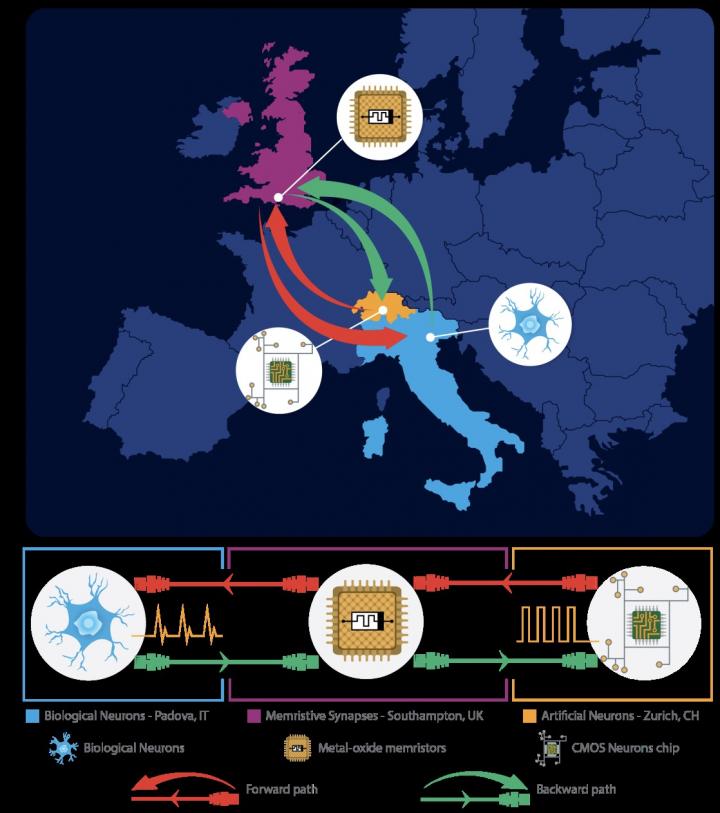
A February 26, 2020 University of Southampton press release (also on EurekAlert) describes this work,
Research on novel nanoelectronics devices led by the University of Southampton enabled brain neurons and artificial neurons to communicate with each other. This study has for the first time shown how three key emerging technologies can work together: brain-computer interfaces, artificial neural networks and advanced memory technologies (also known as memristors). The discovery opens the door to further significant developments in neural and artificial intelligence research.
Brain functions are made possible by circuits of spiking neurons, connected together by microscopic, but highly complex links called ‘synapses’. In this new study, published in the scientific journal Nature Scientific Reports, the scientists created a hybrid neural network where biological and artificial neurons in different parts of the world were able to communicate with each other over the internet through a hub of artificial synapses made using cutting-edge nanotechnology. This is the first time the three components have come together in a unified network.
During the study, researchers based at the University of Padova in Italy cultivated rat neurons in their laboratory, whilst partners from the University of Zurich and ETH Zurich created artificial neurons on Silicon microchips. The virtual laboratory was brought together via an elaborate setup controlling nanoelectronic synapses developed at the University of Southampton. These synaptic devices are known as memristors.
The Southampton based researchers captured spiking events being sent over the internet from the biological neurons in Italy and then distributed them to the memristive synapses. Responses were then sent onward to the artificial neurons in Zurich also in the form of spiking activity. The process simultaneously works in reverse too; from Zurich to Padova. Thus, artificial and biological neurons were able to communicate bidirectionally and in real time.
Themis Prodromakis, Professor of Nanotechnology and Director of the Centre for Electronics Frontiers at the University of Southampton said “One of the biggest challenges in conducting research of this kind and at this level has been integrating such distinct cutting edge technologies and specialist expertise that are not typically found under one roof. By creating a virtual lab we have been able to achieve this.”
The researchers now anticipate that their approach will ignite interest from a range of scientific disciplines and accelerate the pace of innovation and scientific advancement in the field of neural interfaces research. In particular, the ability to seamlessly connect disparate technologies across the globe is a step towards the democratisation of these technologies, removing a significant barrier to collaboration.
Professor Prodromakis added “We are very excited with this new development. On one side it sets the basis for a novel scenario that was never encountered during natural evolution, where biological and artificial neurons are linked together and communicate across global networks; laying the foundations for the Internet of Neuro-electronics. On the other hand, it brings new prospects to neuroprosthetic technologies, paving the way towards research into replacing dysfunctional parts of the brain with AI [artificial intelligence] chips.”
I’m fascinated by this work and after taking a look at the paper, I have to say, the paper is surprisingly accessible. In other words, I think I get the general picture. For example (from the Introduction to the paper; citation and link follow further down),
… To emulate plasticity, the memristor MR1 is operated as a two-terminal device through a control system that receives pre- and post-synaptic depolarisations from one silicon neuron (ANpre) and one biological neuron (BN), respectively. …
If I understand this properly, they’ve integrated a biological neuron and an artificial neuron in a single system across three countries.
For those who care to venture forth, here’s a link and a citation for the paper,
Memristive synapses connect brain and silicon spiking neurons by Alexantrou Serb, Andrea Corna, Richard George, Ali Khiat, Federico Rocchi, Marco Reato, Marta Maschietto, Christian Mayr, Giacomo Indiveri, Stefano Vassanelli & Themistoklis Prodromakis. Scientific Reports volume 10, Article number: 2590 (2020) DOI: https://doi.org/10.1038/s41598-020-58831-9 Published 25 February 2020
The paper is open access.